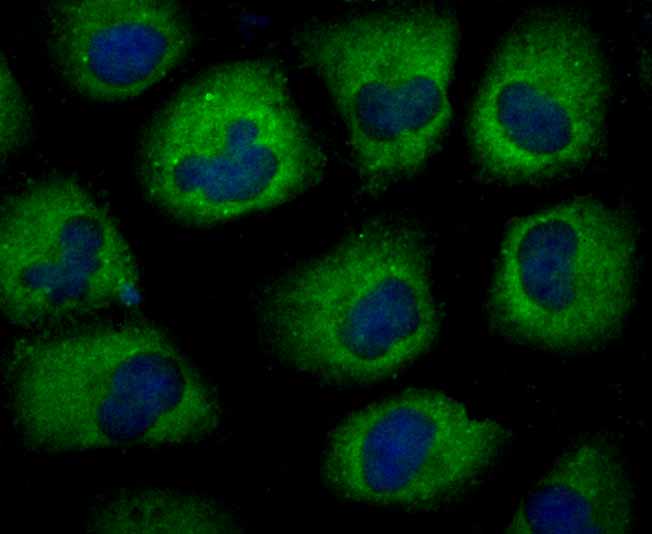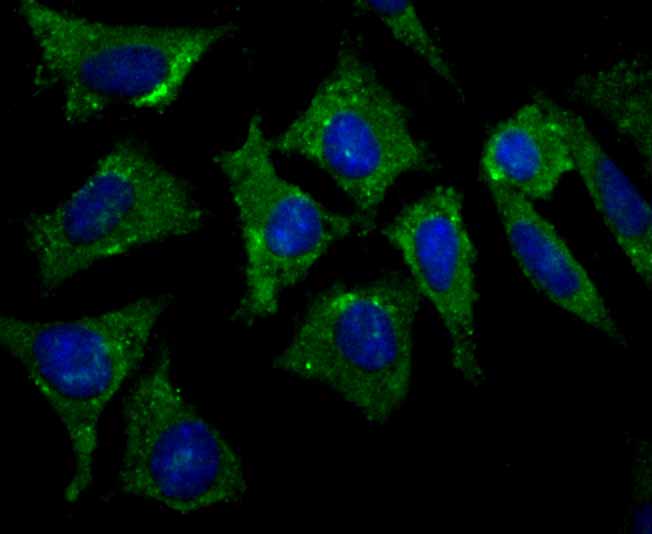Product Name :
APC polyclonal antibody Background :
The adenomatous polyposis syndromes, familial adenomatous polyposis (FAP) and Gardner's syndrome (GS), are characterized by numerous adenomatous polyps throughout the entire colon. These polyps invariably progress to colon cancer in addition to other extracolonic manifestations. The cloning of the APC gene revealed a ubiquitously expressed protein, 2,843 amino acids in length, which is frequently mutated in patients suffering from FAP and GS. APC has been found to be associated with structural components of intracellular junctions. β-catenin and γ-catenin (also called plakoglobin), are involved in the regulation of cellular adhesion. APC and E-cadherin compete for binding to specific internal regions of both β- and γ-catenin. Interactions between cytoskeleton and the APC, E-cadherin, β/γ catenin complex are mediated by α-catenin. Product :
Rabbit IgG, 1mg/ml in PBS with 0.02% sodium azide, 50% glycerol, pH7.2 Storage&Stability :
Store at +4°C after thawing. Aliquot store at -20°C or -80°C. Avoid repeated freeze / thaw cycles. Specificity :
APC polyclonal antibody detects endogenous levels of APC protein. Immunogen :
Peptide Conjugate :
Unconjugated Modification :
Unmodification
APC polyclonal antibody Background :
The adenomatous polyposis syndromes, familial adenomatous polyposis (FAP) and Gardner's syndrome (GS), are characterized by numerous adenomatous polyps throughout the entire colon. These polyps invariably progress to colon cancer in addition to other extracolonic manifestations. The cloning of the APC gene revealed a ubiquitously expressed protein, 2,843 amino acids in length, which is frequently mutated in patients suffering from FAP and GS. APC has been found to be associated with structural components of intracellular junctions. β-catenin and γ-catenin (also called plakoglobin), are involved in the regulation of cellular adhesion. APC and E-cadherin compete for binding to specific internal regions of both β- and γ-catenin. Interactions between cytoskeleton and the APC, E-cadherin, β/γ catenin complex are mediated by α-catenin. Product :
Rabbit IgG, 1mg/ml in PBS with 0.02% sodium azide, 50% glycerol, pH7.2 Storage&Stability :
Store at +4°C after thawing. Aliquot store at -20°C or -80°C. Avoid repeated freeze / thaw cycles. Specificity :
APC polyclonal antibody detects endogenous levels of APC protein. Immunogen :
Peptide Conjugate :
Unconjugated Modification :
Unmodification
-
 ICC staining APC in HUVEC cells (green). The nuclear counter stain is DAPI (blue). Cells were fixed in paraformaldehyde, permeabilised with 0.25% Triton X100/PBS.
ICC staining APC in HUVEC cells (green). The nuclear counter stain is DAPI (blue). Cells were fixed in paraformaldehyde, permeabilised with 0.25% Triton X100/PBS. -
 ICC staining APC in SH-SY-5Y cells (green). The nuclear counter stain is DAPI (blue). Cells were fixed in paraformaldehyde, permeabilised with 0.25% Triton X100/PBS.
ICC staining APC in SH-SY-5Y cells (green). The nuclear counter stain is DAPI (blue). Cells were fixed in paraformaldehyde, permeabilised with 0.25% Triton X100/PBS.
Bioworld Biotech only provide peptides for our antibodies and do not provide additional peptide customization services.
Price/Size :
USD 368/1mg/vial
Tips:
For phospho antibody, we provide phospho peptide(0.5mg) and non-phospho peptide(0.5mg).Describe :
Blocking peptides are peptides that bind specifically to the target antibody and block antibody binding. These peptide usually contains the epitope recognized by the antibody. Antibodies bound to the blocking peptide no longer bind to the epitope on the target protein. This mechanism is useful when non-specific binding is an issue, for example, in Western blotting (WB) and Immunohistochemistry (IHC). By comparing the staining from the blocked antibody versus the antibody alone, one can see which staining is specific; Specific binding will be absent from the western blot or IHC performed with the neutralized antibody.Formula:
Synthetic peptide was lyophilized with 100% acetonitrile and is supplied as a powder. Reconstitute with 0.1 ml DI water for a final concentration of 10 mg/ml.The purity is >90%,tested by HPLC and MS.
Storage:
The freeze-dried powder is more stable. For short time at 2-8°C. For long term storage store at -20°C.
Note :
This product is for research use only (RUO only). Not for use in diagnostic or therapeutic procedures.
 APC polyclonal antibody
APC polyclonal antibody  Datasheet
Datasheet COA
COA MSDS
MSDS SHIP
SHIP